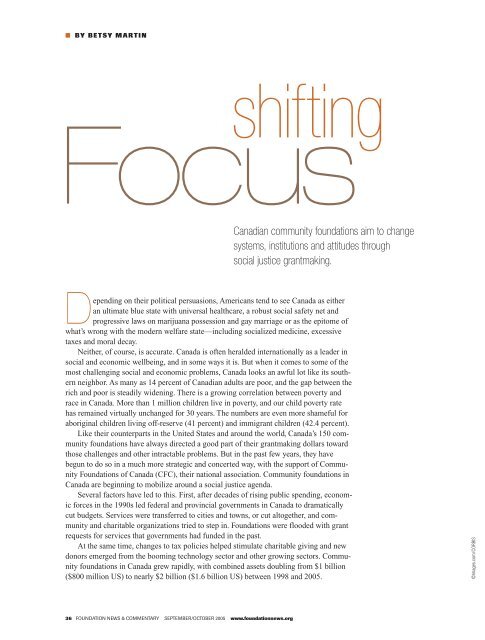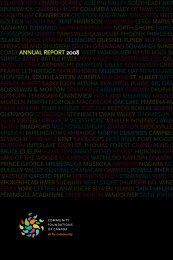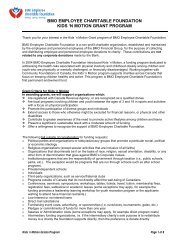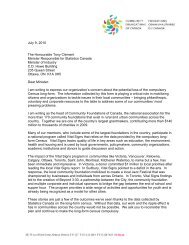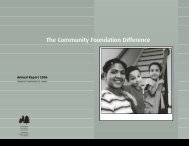Canadian community foundations aim to change systems ...
Canadian community foundations aim to change systems ...
Canadian community foundations aim to change systems ...
You also want an ePaper? Increase the reach of your titles
YUMPU automatically turns print PDFs into web optimized ePapers that Google loves.
■ BY BETSY MARTIN<br />
shifting<br />
Focus<br />
<strong>Canadian</strong> <strong>community</strong> <strong>foundations</strong> <strong>aim</strong> <strong>to</strong> <strong>change</strong><br />
<strong>systems</strong>, institutions and attitudes through<br />
social justice grantmaking.<br />
Depending on their political persuasions, Americans tend <strong>to</strong> see Canada as either<br />
an ultimate blue state with universal healthcare, a robust social safety net and<br />
progressive laws on marijuana possession and gay marriage or as the epi<strong>to</strong>me of<br />
what’s wrong with the modern welfare state—including socialized medicine, excessive<br />
taxes and moral decay.<br />
Neither, of course, is accurate. Canada is often heralded internationally as a leader in<br />
social and economic wellbeing, and in some ways it is. But when it comes <strong>to</strong> some of the<br />
most challenging social and economic problems, Canada looks an awful lot like its southern<br />
neighbor. As many as 14 percent of <strong>Canadian</strong> adults are poor, and the gap between the<br />
rich and poor is steadily widening. There is a growing correlation between poverty and<br />
race in Canada. More than 1 million children live in poverty, and our child poverty rate<br />
has remained virtually un<strong>change</strong>d for 30 years. The numbers are even more shameful for<br />
aboriginal children living off-reserve (41 percent) and immigrant children (42.4 percent).<br />
Like their counterparts in the United States and around the world, Canada’s 150 <strong>community</strong><br />
<strong>foundations</strong> have always directed a good part of their grantmaking dollars <strong>to</strong>ward<br />
those challenges and other intractable problems. But in the past few years, they have<br />
begun <strong>to</strong> do so in a much more strategic and concerted way, with the support of Community<br />
Foundations of Canada (CFC), their national association. Community <strong>foundations</strong> in<br />
Canada are beginning <strong>to</strong> mobilize around a social justice agenda.<br />
Several fac<strong>to</strong>rs have led <strong>to</strong> this. First, after decades of rising public spending, economic<br />
forces in the 1990s led federal and provincial governments in Canada <strong>to</strong> dramatically<br />
cut budgets. Services were transferred <strong>to</strong> cities and <strong>to</strong>wns, or cut al<strong>to</strong>gether, and <strong>community</strong><br />
and charitable organizations tried <strong>to</strong> step in. Foundations were flooded with grant<br />
requests for services that governments had funded in the past.<br />
At the same time, <strong>change</strong>s <strong>to</strong> tax policies helped stimulate charitable giving and new<br />
donors emerged from the booming technology sec<strong>to</strong>r and other growing sec<strong>to</strong>rs. Community<br />
<strong>foundations</strong> in Canada grew rapidly, with combined assets doubling from $1 billion<br />
($800 million US) <strong>to</strong> nearly $2 billion ($1.6 billion US) between 1998 and 2005.<br />
©Images.com/CORBIS<br />
36 FOUNDATION NEWS & COMMENTARY SEPTEMBER/OCTOBER 2005 www.foundationnews.org
www.foundationnews.org FOUNDATION NEWS & COMMENTARY SEPTEMBER/OCTOBER 2005 37
shifting<br />
Focus<br />
Through our social justice focus, we want <strong>to</strong> <strong>change</strong> <strong>systems</strong>,<br />
and economic participation of all <strong>Canadian</strong>s.<br />
In the midst of this dramatic growth, CFC and<br />
its member <strong>community</strong> <strong>foundations</strong> in Canada<br />
faced a disturbing dicho<strong>to</strong>my. Although <strong>community</strong><br />
foundation assets and grants were at record<br />
levels, so were poverty rates, environmental decay<br />
and the struggles of immigrants trying <strong>to</strong> get a<br />
foothold in their new land. Community <strong>foundations</strong><br />
felt an obligation <strong>to</strong> use their growing assets<br />
<strong>to</strong> tackle the root causes of some of the <strong>to</strong>ughest<br />
challenges facing their communities, and were<br />
exploring how <strong>to</strong> do so.<br />
Getting Started<br />
As a few of Canada’s leading <strong>community</strong> <strong>foundations</strong><br />
were rethinking their roles, CFC organized<br />
a symposium in January 2002—Moving Beyond<br />
the Traditional Charitable Roles. We invited<br />
speakers from the United States and Northern<br />
Ireland, as well as Canada. At the end of the discussions,<br />
the conclusion was unanimous—Canada’s<br />
<strong>community</strong> <strong>foundations</strong> needed <strong>to</strong> focus<br />
on social justice. By this we mean investing a<br />
<strong>community</strong> foundation’s resources (financial and<br />
other) <strong>to</strong> address underlying causes, rather than<br />
simply <strong>to</strong> treat symp<strong>to</strong>ms. Through our social<br />
justice focus, we want <strong>to</strong> <strong>change</strong> <strong>systems</strong>, institutions<br />
and attitudes that act as barriers <strong>to</strong> the full<br />
social and economic participation of all <strong>Canadian</strong>s.<br />
With support from the Ford Foundation and<br />
the Atkinson Charitable Foundation in Toron<strong>to</strong>,<br />
we set out <strong>to</strong> increase the commitment and capacity<br />
of <strong>community</strong> <strong>foundations</strong> <strong>to</strong> do more of<br />
their work from a social justice perspective. We<br />
focused on three things:<br />
1. Increasing foundation awareness of social<br />
justice issues <strong>to</strong> encourage more <strong>foundations</strong> <strong>to</strong><br />
see them as a legitimate focus. To launch this,<br />
we co-hosted with The Winnipeg Foundation<br />
a social justice forum that brought <strong>community</strong><br />
foundation representatives <strong>to</strong>gether with social<br />
justice leaders. They explored issues, potential<br />
roles and the implications of adopting a social<br />
justice perspective. For example, would it turn<br />
The<br />
Case<br />
Studies<br />
Toron<strong>to</strong> Innovation Creates<br />
Affordable Housing<br />
A distinguishing feature of social justice philanthropy<br />
is that it works at systemic and institutional levels <strong>to</strong><br />
advance positive <strong>change</strong>. One of Canada’s most successful<br />
examples involves an innovative public/private/<br />
nonprofit partnership convened by the Toron<strong>to</strong> Community<br />
Foundation (TCF) <strong>to</strong> help address the city’s need for<br />
affordable housing.<br />
Each year, TCF publishes Toron<strong>to</strong>’s Vital Signs ®<br />
(www.tcf.ca), a report card tracking Toron<strong>to</strong>’s quality<br />
of life in ten areas, including housing. The 2004 report<br />
showed almost 70,000 households were on the city’s<br />
waiting list for subsidized housing. The foundation<br />
also found that Toron<strong>to</strong>’s apartment vacancy rate had<br />
reached an all-time high—at least 10,000 apartments<br />
were sitting vacant.<br />
Government funding was restricted <strong>to</strong> new construction<br />
projects and budget constraints at the municipal<br />
and provincial levels meant new housing projects<br />
were slow <strong>to</strong> develop. Existing rental units clearly represented<br />
an untapped resource.<br />
In March 2004, TCF began talking with housing<br />
advocates, private landlords, the public housing authority<br />
and governments. The Greater Toron<strong>to</strong> Apartment<br />
Association (representing local landlords), the Toron<strong>to</strong><br />
Community Housing Corporation and the mayor’s housing<br />
advisor sat down with the foundation <strong>to</strong> explore ways<br />
the current housing s<strong>to</strong>ck could be better used <strong>to</strong> meet<br />
<strong>community</strong> needs. Working <strong>to</strong>gether, they came up with<br />
a potential <strong>to</strong>ol for <strong>change</strong>—a $300 ($240 US) monthly<br />
housing allowance, cost-shared by landlords and government,<br />
that would bridge the gap between market<br />
rents and tenants’ ability <strong>to</strong> pay.<br />
Led by TCF, the group proposed a pilot program <strong>to</strong><br />
the Ontario government that enabled it <strong>to</strong> create housing<br />
allowances at a 50 percent discount. Nine months<br />
38 FOUNDATION NEWS & COMMENTARY 38 FOUNDATION SEPTEMBER/OCTOBER NEWS & COMMENTARY 2005 www.foundationnews.org<br />
SEPTEMBER/OCTOBER 2005 www.foundationnews.org
institutions and attitudes that act as barriers <strong>to</strong> full social<br />
off donors—as some feared—or would it attract<br />
those who really want <strong>to</strong> make a difference? (The<br />
experience <strong>to</strong> date indicates that the perspective<br />
attracts donors.) However, because influencing<br />
public policy is one of the goals of social justice<br />
work, we had <strong>to</strong> ask ourselves, do we know how<br />
<strong>to</strong> engage in advocacy? Generally, this is not a<br />
<strong>community</strong> foundation strong suit.<br />
2. We <strong>aim</strong>ed specifically <strong>to</strong> support our leading<br />
edge <strong>foundations</strong> and build the capacity <strong>to</strong><br />
effectively engage in social justice grantmaking,<br />
<strong>community</strong> leadership, advocacy and other activities.<br />
Because <strong>community</strong> <strong>foundations</strong> excel at<br />
peer learning, we knew that the experiences of<br />
those <strong>foundations</strong> would help spread the concept<br />
throughout Canada, so we have focused on telling<br />
their s<strong>to</strong>ries (see sidebars). CFC’s Social Justice<br />
Learning Group now regularly brings <strong>to</strong>gether a<br />
group of seven <strong>community</strong> foundation representatives<br />
who are actively engaged in social justice<br />
work. They are supporting and learning from one<br />
another, and beginning <strong>to</strong> identify opportunities<br />
for <strong>Canadian</strong> <strong>community</strong> <strong>foundations</strong> <strong>to</strong> work<br />
<strong>to</strong>gether on issues such as poverty.<br />
3. We wanted <strong>to</strong> add <strong>to</strong> the currently limited<br />
body of research on <strong>foundations</strong> and social justice,<br />
and <strong>to</strong> develop practical <strong>to</strong>ols for <strong>foundations</strong>.<br />
We started with two background papers <strong>to</strong><br />
help our members think about the meaning—and<br />
ramifications—of social justice grantmaking.<br />
We also published a primer on the legislative and<br />
regula<strong>to</strong>ry environment as it relates <strong>to</strong> advocacy<br />
on the part of <strong>foundations</strong> and their grantees. And<br />
CFC’s Social Justice Spectrum (www. <strong>community</strong><br />
fdn.ca/link_docs/SpectrumNov2004%2Epdf)<br />
helps <strong>foundations</strong> understand the potential range<br />
of social justice work.<br />
Going Deeper<br />
We are keenly aware that our social justice efforts<br />
are in their infancy and that we have much <strong>to</strong><br />
learn from other networks in Canada and around<br />
the world. However, during his speech at the 2004<br />
Symposium on a Global Movement in Berlin,<br />
after its first explora<strong>to</strong>ry meeting, TCF and its partners<br />
announced a $7.2 million ($5.76 million US), five-year<br />
housing allowance pilot program in Toron<strong>to</strong>.<br />
Because of this initiative, 400 individuals and families<br />
moved in<strong>to</strong> affordable homes this summer. Recognizing<br />
the benefits of using existing housing s<strong>to</strong>ck, the<br />
federal and provincial governments have now amended<br />
their housing funding policies <strong>to</strong> enable additional housing<br />
allowances. A 5,000-unit expansion of the Toron<strong>to</strong><br />
model is now expected across the province and may<br />
extend across the country.<br />
Hamil<strong>to</strong>n Commits <strong>to</strong><br />
Poverty Reduction<br />
Located less than an hour’s drive from Toron<strong>to</strong>, the<br />
city of Hamil<strong>to</strong>n, population 500,000, has the highest<br />
poverty rate in Ontario. One in five (100,000) of its<br />
residents live in low-income households. The numbers<br />
are even higher among children under 12 (25 percent),<br />
seniors over 75 (29 percent) and recent immigrants (52<br />
percent).<br />
In the past decade, the wealthiest 40 percent<br />
of Hamil<strong>to</strong>n’s citizens have experienced increasing<br />
incomes, while the poorest 60 percent have watched<br />
their incomes drop even further. At the same time, some<br />
of the city’s biggest and best-known employers have<br />
either filed for bankruptcy protection or closed up shop.<br />
The Hamil<strong>to</strong>n Community Foundation (HCF) knew<br />
the situation demanded bold action. After extensive<br />
consultation, the foundation responded by becoming<br />
the first <strong>community</strong> foundation in Canada <strong>to</strong> commit its<br />
entire unrestricted <strong>community</strong> fund <strong>to</strong> a single cause—<br />
poverty reduction.<br />
In February 2004, HCF launched Tackling Poverty<br />
Together. The four-year initiative will provide at least<br />
$3 million ($2.4 million US) <strong>to</strong> charitable organizations<br />
focusing on innovative poverty prevention and reduction.<br />
www.foundationnews.org FOUNDATION www.foundationnews.org NEWS & COMMENTARY FOUNDATION SEPTEMBER/OCTOBER NEWS & COMMENTARY 2005 39 SEPTEMBER/OCTOBER 2005 39
shifting<br />
Focus<br />
Engaging in advocacy is not generally a <strong>community</strong> foundation<br />
Emmett D. Carson, president and CEO of The<br />
Minneapolis Foundation, recognized one of the<br />
strengths we bring <strong>to</strong> our social justice work—<br />
our clear intention <strong>to</strong> encourage and focus our<br />
members on social justice grantmaking. (For<br />
more, see “Standing at the Crossroads,” Foundation<br />
News & Commentary, January/February<br />
2005, www.foundationnews.org/CME/article.<br />
cfm?ID=3166.)<br />
It is essential that this work be undertaken<br />
not just within a few <strong>foundations</strong>, but also as an<br />
endeavour of the entire national network. Obviously,<br />
our members are independent and will<br />
make their own decisions about if, when and how<br />
<strong>to</strong> integrate a social justice perspective in<strong>to</strong> their<br />
work. But, by actively working with <strong>foundations</strong><br />
on the leading edge of this work and bringing it<br />
<strong>to</strong> the attention of every CFC member, we hope <strong>to</strong><br />
move forward on key national initiatives.<br />
For example, Canada has a population of<br />
approximately 30 million, or one-tenth the size<br />
of the United States. Immigration now accounts<br />
for more than half of our population growth and<br />
has dramatically increased Canada’s ethnic and<br />
racial diversity. In the last decade, three-quarters<br />
of immigrants <strong>to</strong> Canada were people of color.<br />
This diversity has added a rich texture <strong>to</strong> <strong>Canadian</strong><br />
life—and new challenges for cities such as<br />
Toron<strong>to</strong>, Vancouver and Montreal, where most<br />
immigrants settle.<br />
Our labor market growth depends on immigrants,<br />
but they face significant barriers once<br />
they arrive. Despite the fact that immigrants<br />
come with generally higher degrees of education,<br />
greater professional credentials and more financial<br />
resources than in the past, we continue <strong>to</strong><br />
discount their experience, education and training.<br />
This results in a $4 billion ($3.2 billion US) loss<br />
<strong>to</strong> the economy, not <strong>to</strong> mention un<strong>to</strong>ld losses <strong>to</strong><br />
the immigrants themselves.<br />
To help <strong>community</strong> <strong>foundations</strong> effectively<br />
address such immigration issues, CFC has<br />
launched a research project with the Law Commission<br />
of Canada funded by the Walter and<br />
The<br />
Case<br />
Studies<br />
Soon after HCF announced its poverty initiative,<br />
Hamil<strong>to</strong>n’s city government offered <strong>to</strong> co-convene a<br />
citywide roundtable <strong>to</strong> build on the foundation’s efforts.<br />
Less than one year later, HCF and the city are leading<br />
the Hamil<strong>to</strong>n Roundtable for Poverty Reduction, which<br />
brings <strong>to</strong>gether 25 <strong>community</strong> leaders <strong>to</strong> mobilize a<br />
<strong>community</strong>wide focus on poverty reduction.<br />
Together with individuals living in poverty, the business<br />
<strong>community</strong>, voluntary organizations and three levels<br />
of government, roundtable members are developing<br />
a multiyear poverty reduction plan and establishing a<br />
framework <strong>to</strong> implement, evaluate and finance the plan<br />
over the next four years.<br />
Financing will come from all sec<strong>to</strong>rs and key<br />
institutions are contributing in other ways as well. For<br />
example, The Hamil<strong>to</strong>n Specta<strong>to</strong>r (www.hamil<strong>to</strong>nspecta<br />
<strong>to</strong>r.com) will focus its reporting, edi<strong>to</strong>rial and <strong>community</strong><br />
relations efforts on poverty reduction and 30 member<br />
businesses of the chamber of commerce have formed a<br />
<strong>community</strong> development committee <strong>to</strong> help.<br />
As the first initiative of its kind co-led by a <strong>Canadian</strong><br />
<strong>community</strong> foundation and a local government, it has<br />
the potential <strong>to</strong> demonstrate how two key institutions<br />
and their partners can focus the <strong>community</strong>’s energy<br />
and resources on a critical issue.<br />
Winnipeg Focuses on<br />
One Neighborhood School<br />
The Centennial Neighbourhood Project was started by<br />
The Winnipeg Foundation in 2003 with $2.5 million<br />
($2 million US) in foundation funding and a five-year<br />
commitment <strong>to</strong> test the theory that education is the<br />
ticket out of poverty. The foundation, neighborhood<br />
residents and agencies and other partners developed<br />
an innovative initiative that seeks <strong>to</strong> demonstrate that<br />
appropriate school and <strong>community</strong> supports can significantly<br />
improve the prospects of students and their fami-<br />
40 FOUNDATION NEWS & COMMENTARY 40 FOUNDATION SEPTEMBER/OCTOBER NEWS & COMMENTARY 2005 www.foundationnews.org<br />
SEPTEMBER/OCTOBER 2005 www.foundationnews.org
strong suit, but it is one that needs <strong>to</strong> be worked on.<br />
Duncan Gordon Foundation. The Community<br />
Scholar in Law Reform initiative will document<br />
how <strong>Canadian</strong> law and social policy impede<br />
immigrant settlement and propose policy and program<br />
<strong>change</strong>s <strong>to</strong> help new <strong>Canadian</strong>s thrive.<br />
As described in “The Case Studies,” beginning<br />
on page 36, several member <strong>foundations</strong> are<br />
leading significant poverty reduction initiatives.<br />
CFC hopes <strong>to</strong> access a new federal program <strong>to</strong><br />
build on their work and frame an antipoverty<br />
agenda for <strong>Canadian</strong> <strong>community</strong> <strong>foundations</strong>.<br />
Many of our <strong>community</strong> <strong>foundations</strong> are<br />
also interested in replicating the Toron<strong>to</strong><br />
Community Foundation’s (TCF) approach <strong>to</strong><br />
tracking trends and mobilizing <strong>community</strong><br />
response <strong>to</strong> social justice issues, such as the gap<br />
between rich and poor, access <strong>to</strong> work and<br />
affordable housing. CFC is working with TCF<br />
and other <strong>foundations</strong> on a nationally coordinated<br />
approach <strong>to</strong> this work.<br />
Finally, CFC is collecting baseline information<br />
from members <strong>to</strong> determine the level of<br />
social justice grantmaking. We’re also trying <strong>to</strong><br />
gauge board and staff attitudes <strong>to</strong>ward a “social<br />
justice lens” for their work, a <strong>to</strong>ol we recently<br />
introduced. We will have some initial results for<br />
the Council on Foundations’ Community Foundation<br />
Conference in Seattle, where we will be<br />
coordinating a panel discussion with representatives<br />
from Canada, the United States and Mexico.<br />
(For more on the September 19–21 conference<br />
and this session, “Mobilizing Community Foundations<br />
for Social Justice,” visit www.cof.org.)<br />
Additional Resources<br />
Community Foundations of Canada has created<br />
and compiled a series of resources around the<br />
issue of social justice that can be found at www.<br />
<strong>community</strong>-fdn.ca/socialjustice.<br />
Betsy Martin (betsy.martin@sympatico.ca) is a<br />
senior advisor and program consultant with Community<br />
Foundations of Canada. She is leading<br />
CFC’s national Social Justice Initiative.<br />
lies in one of the city’s most disadvantaged areas.<br />
To put those supports in place, the foundation<br />
worked on three levels: first, the creation of a residents’<br />
committee <strong>to</strong> lead <strong>change</strong> from the ground up; second,<br />
an interagency committee <strong>to</strong> support the residents’<br />
efforts; and finally, a funders’ committee <strong>to</strong> bring funders<br />
<strong>to</strong>gether from the volunteer, public and private sec<strong>to</strong>rs.<br />
Two years later, improvements are being seen at<br />
every level. A new residents’ group is working on an<br />
overall neighborhood plan focusing on safety and housing.<br />
The interagency committee has identified and filled<br />
a number of critical gaps at Dufferin School, such as<br />
the lack of aboriginal agencies working in the neighborhood.<br />
Approximately 90 percent of Dufferin’s students<br />
are aboriginal, but the school had no aboriginal teachers.<br />
Local agencies brought five aboriginal teaching<br />
assistants—hired from within the Centennial neighborhood—<strong>to</strong><br />
Dufferin. The assistants have brought native<br />
knowledge in<strong>to</strong> the classroom and curriculum.<br />
The committee also worked closely with provincial<br />
and federal native housing associations <strong>to</strong> push for<br />
more off-reserve housing in Centennial. The <strong>community</strong><br />
recently received ten new rent-geared-<strong>to</strong>-income<br />
units—among the first built in Canada in more than a<br />
decade.<br />
The multiple funders involved in the Centennial<br />
program are collaborating in innovative ways. The<br />
school division agreed <strong>to</strong> upgrade the <strong>community</strong>’s support<br />
staff person <strong>to</strong> full-time. The province is staffing a<br />
new family resource center and has given Centennial<br />
a “Neighbourhoods Alive” designation, which makes<br />
it eligible for other resources. The federal government<br />
agreed <strong>to</strong> set up what may be its first school-based<br />
early years education program. The early results from<br />
Centennial look promising, with tremendous potential for<br />
best practices <strong>to</strong> be shared and replicated in other inner<br />
city communities.<br />
www.foundationnews.org FOUNDATION www.foundationnews.org NEWS & COMMENTARY FOUNDATION SEPTEMBER/OCTOBER NEWS & COMMENTARY 2005 41 SEPTEMBER/OCTOBER 2005 41


